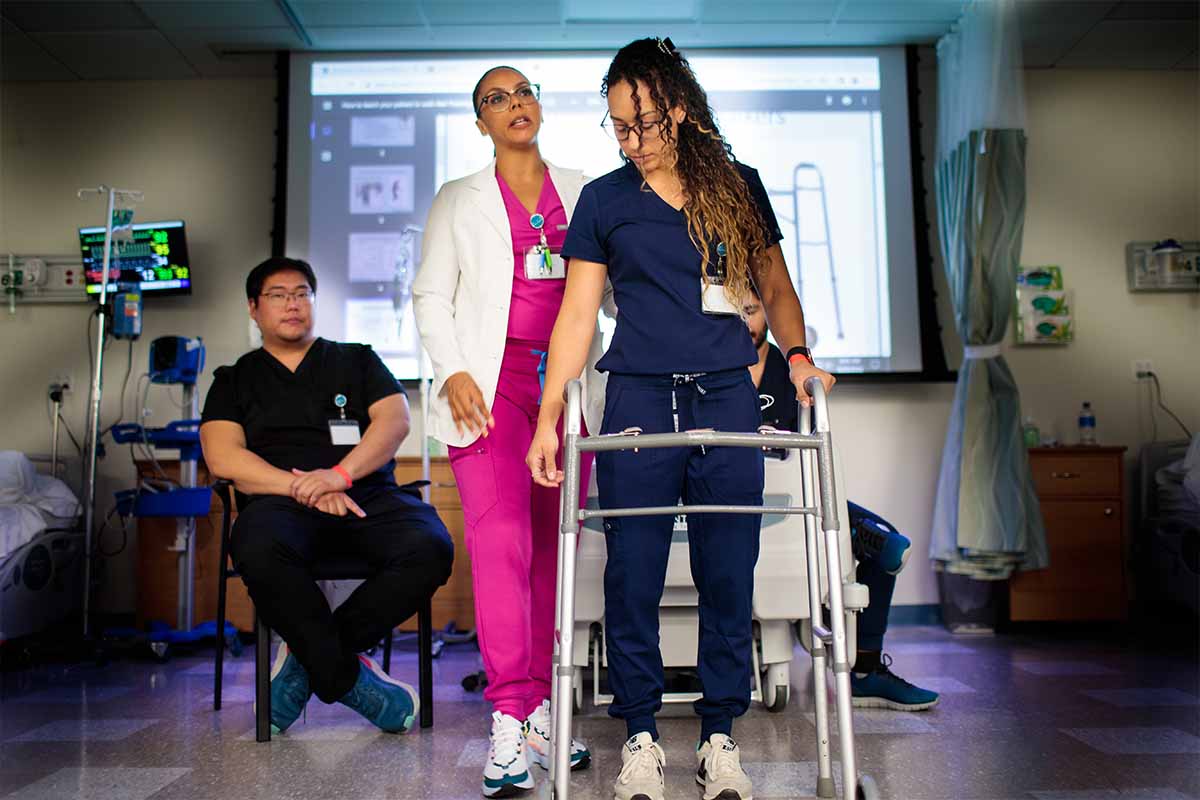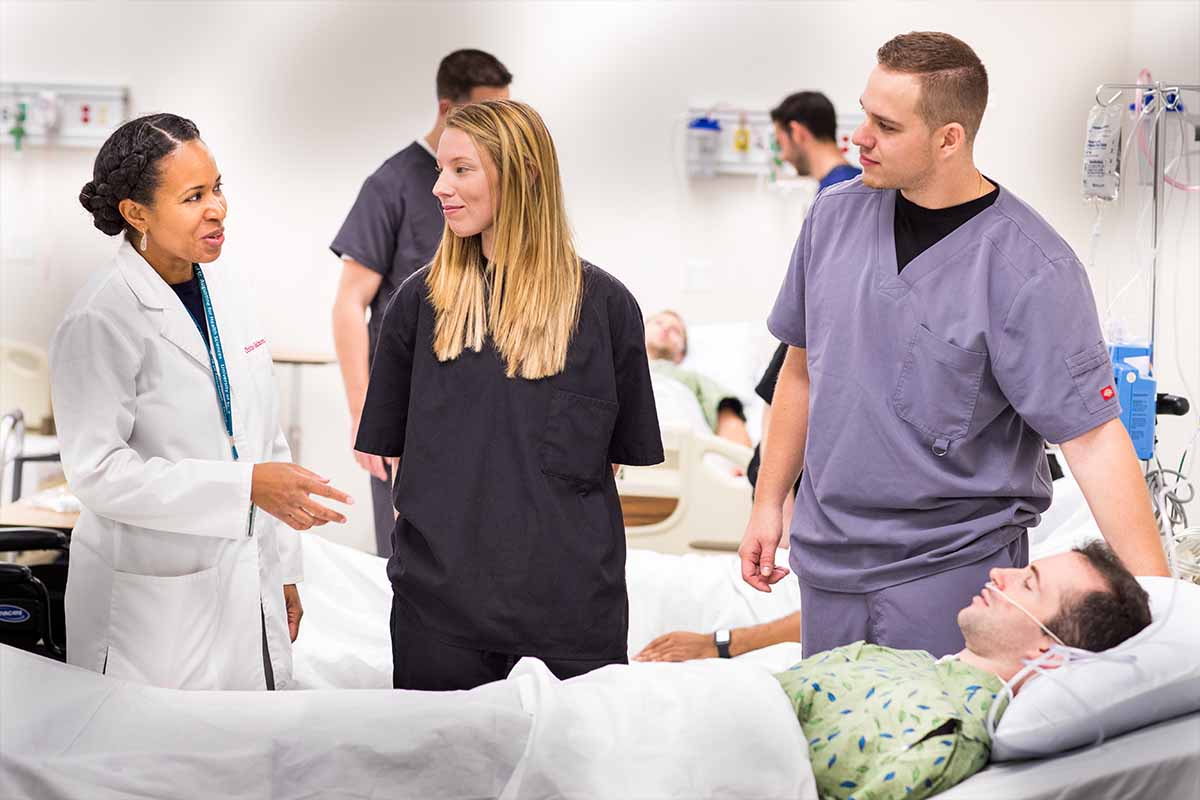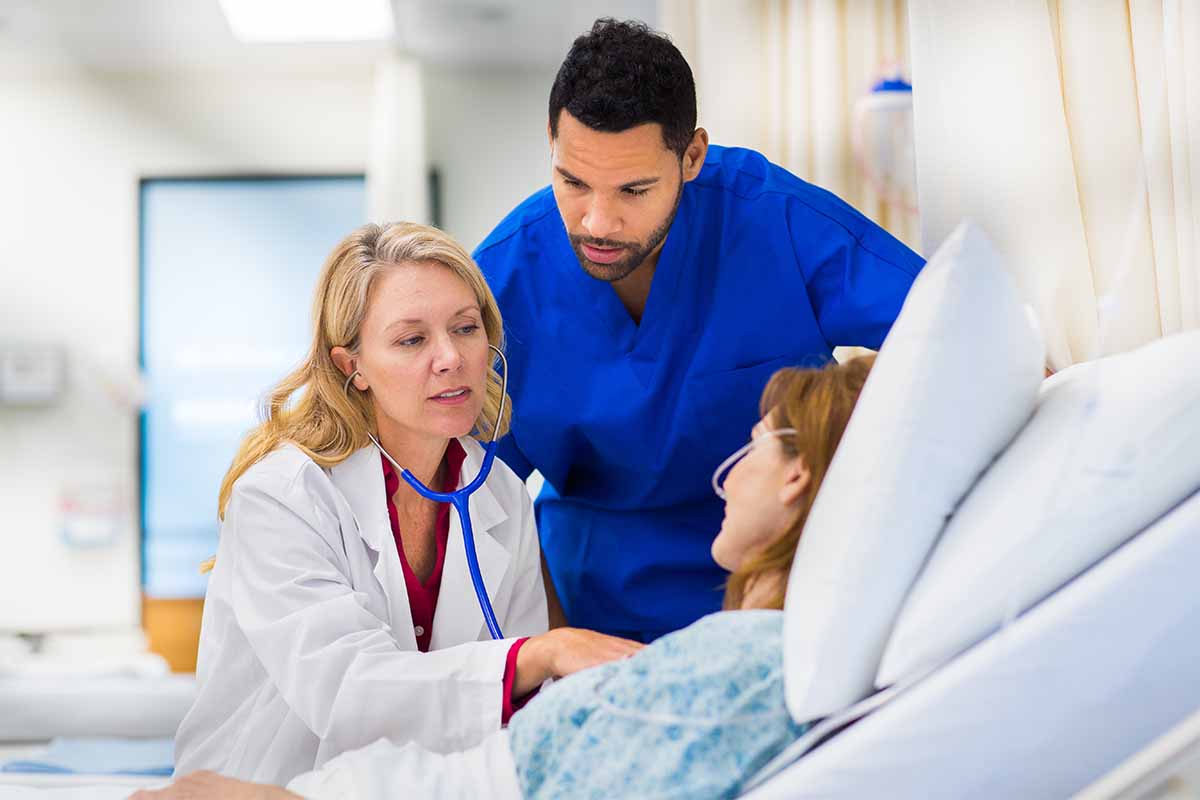
“I went to grad school thinking I wanted to work with kids,” said Dr. Meghan Savage, CCC-SLP, PhD, a core faculty member in the Master of Science in Speech-Language Pathology (MS-SLP) program on USAHS’s Austin campus. But when she had the chance to work with people who were recovering from cerebrovascular accidents (CVAs), or strokes, she changed her focus. “This population is so motivated, and I’m drawn to that. They know what they’ve lost—and they know what they want to get back.”
She added, “They look at you like you’re the only person who’s really trying to communicate with them.”
Dr. Savage has more than a decade of clinical expertise with clients who are recovering from left-hemisphere CVAs. She spoke to us about common post-stroke communication disorders, the interventions that speech-language pathologists (SLPs) use to help patients improve their language skills—and how our students are practicing these interventions in our simulation labs and beyond.
Speech-Language Disorders
Aphasia, Apraxia of Speech, and Dysarthria
The three most common post-stroke fluency disorders are aphasia, apraxia of speech, and dysarthria. Typically, a person with aphasia has trouble forming words and sentences when speaking and writing. Aphasia may affect their ability to understand language and to read as well, depending on where the stroke happened in the brain. About one-third of strokes result in aphasia, and the condition affects more than 2 million adults in the United States.
“If you have a word-finding problem, it’s like the word is on the other side of the river, and you can see it, but you just can’t reach it,” Dr. Savage explained, paraphrasing author Tom Broussard, who has spoken to USAHS about his experience with aphasia. “SLPs build bridges to cross the river.”
By contrast, apraxia of speech is a motor planning problem—a disconnect in the motor sequencing of speaking. And in dysarthria, the muscles used for speech are impaired, which causes the person’s speech to sounds to be imprecise or unintelligible.
Dr. Savage did her PhD dissertation on conversational abilities in people with aphasia. She worked on developing a new treatment to improve their conversation skills—discerning exactly where the person has a breakdown and retraining them there.
Interventions for Speech-Language Disorders
Interventions for aphasia include semantic feature analysis. For example, if the patient can’t find the word “spatula,” the SLP helps them learn to talk around the word, describing the features of a spatula and what it does. Because the brain stores information in neural networks, this circumlocution strategy often helps them find the word.
If the patient can’t produce verbs, the SLP can play word games with the patient focusing on verbs to help rebuild neural connections. If the patient’s grammar is affected, the SLP can retrain correct sentence structures. SLPs also train the patient’s family members and caregivers in using conversation cues and other language development strategies.
Swallowing Disorders
Diagnosing Dysphagia
Many people experience dysphagia, or difficulty swallowing, as a result of a stroke. To diagnose the problem, “SLPs do a modified barium swallow study (MBSS), where barium is mixed with foods of different consistencies, and we use video fluoroscopy to visualize the swallow,” Dr. Savage explained. USAHS has had mobile swallow study trucks come to campus to train our students on MBSS. “You can see at what level the problem is happening, and whether the patient is aspirating.” As an intervention for dysphagia, “You can teach the patient compensatory strategies: strengthening the muscles used for swallowing, as well as modifying their diet,” she said.
Endoscopies: Innovative Learning Technology
Endoscopes are another type of diagnostic tool. The clinical simulation centers on our Austin and Dallas campuses are now equipped with two types of endoscopes for student practice. The nasopharyngoscope is a flexible scope with a camera that is inserted into the patient’s nostril, down through the nasal cavity, so the student can observe the patient’s vocal folds. Students practice maneuvering the scope and watch what happens when the patient eats and drinks with it inserted.
The other type is a rigid endoscope, which students use to look at voice and vocal fold function. For example, if the patient has a hoarse voice, are there nodules? How do the vocal folds vibrate when they speak or sing? Dr. Savage noted that it’s rare for universities to make this equipment available for student practice.
Practicing the SLP’s Role on an Interprofessional Team
In our simulation labs, MS-SLP students not only develop skills using clinical equipment—they also practice solving patient problems in simulation scenarios. Some of those simulations are interprofessional: SLP students work with students from our physical therapy (PT) and occupational therapy (OT) programs to practice their role on the team.
For example, for a patient recovering from a stroke, PTs help the patient regain gross motor function and can train other team members on how to best position the patient. OTs help the patient with activities of daily living (ADLs), such as eating with adaptive utensils. SLPs find the best positioning to aid the patient’s speech and swallowing and teach them exercises to improve their swallowing function.
“We can share with other team members what our goals are so that they can practice those goals with the patient as well,” Dr. Savage said. “If the patient has swallowing problems, the SLP can teach the PT and OT how to keep the patient safe. And conversely, SLPs can add PT or OT movement activities to our language activities. Our professions also have overlap in practice areas. If we all target a common goal using techniques from our respective disciplines, we can improve the healthcare of our patients.”
In one scenario that students practice in the lab, the patient can communicate only a few words, but can understand language. The PT helps them walk again; the OT helps with dressing, toileting, and bathing; and the SLP works with communication and swallowing. “Together we explore, where do we share practice areas, where are we different—and how do we communicate?” she said.
A Rewarding Niche
Before joining USAHS in 2018, Dr. Savage ran a stroke support group in a Louisiana hospital. “It was incredible to see their progress,” she said. “Patients shared their success stories and cheered each other on. It’s so good for them to have that camaraderie. It’s a joy to be part of that. They were so grateful.”She said that like her younger self, many students enter USAHS’s MS-SLP program wanting to work with kids. “Some are nervous to work with adults—the population scares them. But it’s exciting to expose them to a new practice area.” She teaches the Adult Neurogenic Disorders class, as well as Motor, Speech & Cognitive Communication Disorders. In their clinical internships, students must complete one school placement, one adult placement, and a third placement of their choice or in an area of need. “The students say, ‘thank you for teaching me about this population,’” Dr. Savage said. One student in her clinical internship told her, “I’ve fallen in love – this is my niche.”
The University of St. Augustine for Health Sciences (USAHS) offers a Master of Science in Speech-Language Pathology (MS-SLP). Designed for working students, the MS-SLP is an online program with four required on-campus residencies on either the USAHS Austin or Dallas campus. The program offers two intakes per year, in January and September. Prepare to make a difference in the lives of clients across the lifespan with a meaningful career in speech therapy!
The Master of Science in Speech-Language Pathology education program at the University of St. Augustine for Health Sciences is a Candidate of Accreditation by the Council on Academic Accreditation in Audiology and Speech-Language Pathology (CAA) of the American Speech-Language-Hearing Association, 2200 Research Boulevard, #310, Rockville, MD 20850, 800-498-2071 or 301-296-5700. Candidacy is a “preaccreditation” status with the CAA awarded to developing or emerging programs for a maximum period of 5 years.
The candidacy status includes the MS-SLP program offered at Austin and Dallas, Texas locations. Visit our website for additional information.










